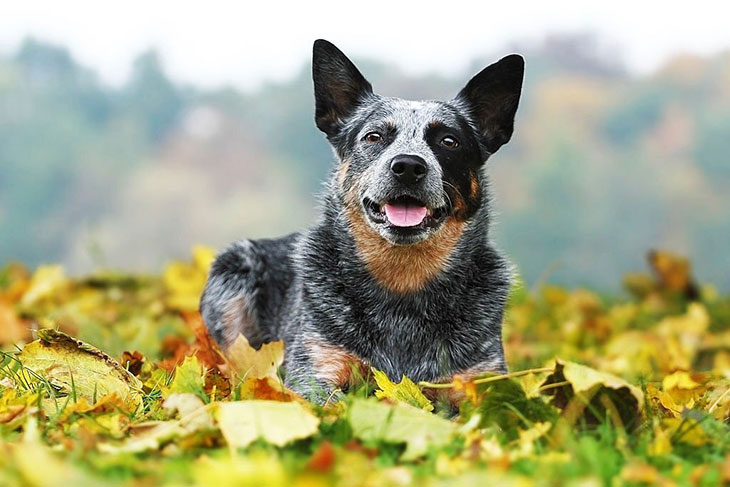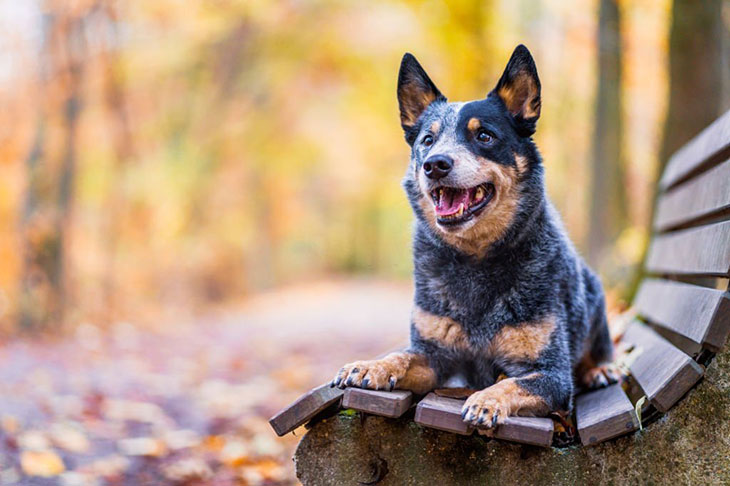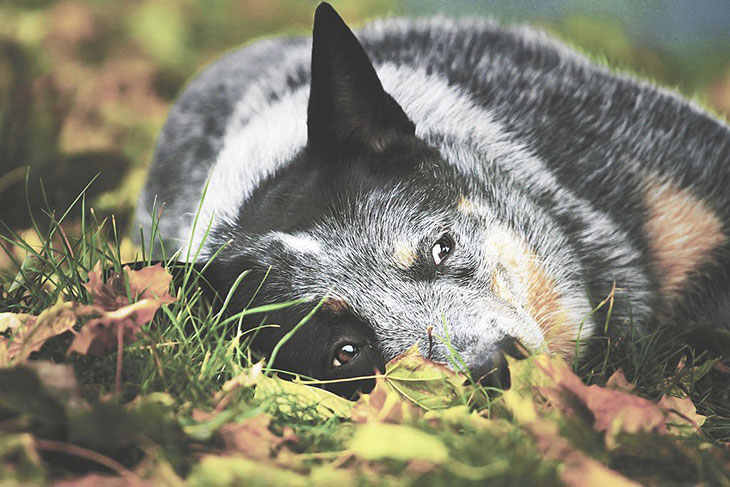Curious about the life span of Blue Heeler? These intelligent and energetic dogs, or Australian Cattle Dogs, make wonderful companions.
In this article, I’ll delve into the factors that influence their life span, explore common health issues to watch for, and provide tips on ensuring your furry friends live a long and fulfilling life.
What Is The Life Span Of A Blue Heeler?

How long do Blue Heeler dogs live? The Blue Heeler lifespan, also known as an Australian Cattle Dog, typically ranges from 12 to 15 years.
This is considered relatively long compared to other breeds of similar size, like Goldendoodle.
However, it’s significant to note that individual dogs may vary, and genetics, diet, exercise, and overall health care can influence their longevity.
With proper care and attention, your family pet can live long and healthy lives, providing companionship and loyalty to their owners for many years.
Regular veterinary check-ups, a balanced diet, daily exercise, mental stimulation, and a loving environment are key factors in promoting well-being and extending the Blue Heeler life expectancy.
Why Do Blue Heelers Have Long Life Expectancy?
Several factors contribute to the life span of a Blue Heeler, including:
Lifestyle
Australian Heelers are active and intelligent dog breeds that require regular exercise and mental stimulation.
Their active lifestyle helps them maintain a healthy weight and prevents obesity-related health issues.
With the necessary activity level and engagement, you can keep these energetic breeds’ bodies and minds in good shape, contributing to a longer lifespan of a Blue Heeler.
Origin
Blue Heelers were bred in Australia for herding cattle in harsh conditions. Their ancestors were selected for their durability, resilience, and overall health.
Over generations, this particular breed has contributed to their robustness and long Australian Cattle dog life span expectancy.
Size
These dogs are medium-sized breed standards, generally weighing from 16 to 23 kilograms (35 to 50 pounds).
Smaller breeds generally tend to have longer life spans than larger ones. The relatively moderate size of your family dog may contribute to its extended lifespan.
What Health Problems Do Blue Heelers Have?

Like any dog breed, such as Border Collie, this modern breed is prone to certain health concerns that potential owners should be aware of.
Here are some common health problems seen in Blue Heelers:
Hip Dysplasia
Hip dysplasia is a usual health concern in Blue Heelers and many other dog breeds.
This genetic condition can be influenced by factors such as rapid growth, excessive exercise at a young age, and improper nutrition.
The signs of illness of hip dysplasia in Blue Heelers may vary from mild to severe. They can include difficulty rising or standing, limping, decreased activity level, pain or stiffness in the hip area and elbow joint, or a noticeable change in gait.
As the condition progresses, it can significantly impact a canine’s mobility and overall life quality.
Eye Issues
Some common eye problems observed in Blue Heelers include:
- Progressive Retinal Atrophy (PRA): A group of genetic diseases that gradually deteriorate the retina, leading to vision loss.
- Collie Eye Anomaly (CEA): A congenital condition affecting herding breeds, causing vision impairment or blindness.
- Cataracts: Clouding of the lens, resulting in blurred vision.
- Cherry Eye: Protrusion of the gland in the corner of the eye, requiring surgical intervention.
- Entropion: Eyelid rolling inward, causing eyelashes to rub against the cornea.
Deafness
Congenital deafness is often linked to the breed’s genetics, specifically the merle gene responsible for their distinctive coat coloration.
It’s important to remember that not all breeds with the Merle coat pattern will be deaf.
Acquired deafness in Blue Heelers can also result from age, injury, ear infections, exposure to loud noises, or certain medications.
Bloat
Bloat, or gastric dilatation-volvulus (GDV), is a serious health issue affecting Blue Heelers and other deep-chested dog breeds.
It is a potentially life-threatening condition that needs immediate veterinary care.
Bloat happens when the dog’s stomach fills with gas, fluid, or food, causing it to expand. The expanded stomach can sometimes twist or rotate, leading to a condition called volvulus.
This twisting can obstruct blood flow to the stomach and other vital organs, resulting in tissue damage and potential organ failure.
Symptoms of bloat in Blue Heelers may include a distended abdomen, restlessness, unproductive attempts to vomit, excessive salivation, difficulty breathing, pale gums, and signs of distress.
It is vital to look for immediate veterinary care if bloat is suspected, as it is a life-threatening emergency.
What To Do To Take Care Of Your Australian Cattle Dog?

Taking care of your Australian Cattle Dog involves several key aspects to ensure their health, happiness, and well-being:
Diet
- Balanced Nutrition: Feed them high-quality dog food designed for active breeds, ensuring it contains a good balance of proteins, carbohydrates, and healthy fats.
- Portion Control: Avoid overfeeding to prevent weight gain. Follow recommended portion sizes based on age, weight, and activity level.
- Regular Feeding Schedule: Establish a consistent schedule with two or three meals daily to aid digestion and provide steady energy.
- No Table Scraps: Avoid sharing human food, as it can be harmful. Stick to a canine diet to maintain proper nutrition.
- Fresh Water: Keep fresh, clean water available to hydrate your Blue Heeler.
- Dietary Restrictions: Some dogs may have specific dietary restrictions or sensitivities. Consult with the vet if you find any issues.
Routine Care: Regularly Grooming And Brushing
Grooming is an important part of caring for your Australian Cattle Dog. Regular brushing assists in removing and preventing matting, loose hair and maintaining a healthy coat.
Blue Heelers have a short and dense double coat, so brushing them once or twice weekly is usually sufficient.
However, more frequent brushing may be necessary during shedding seasons to manage the increased hair loss.
Additionally, check your dog’s ears regularly for any signs of infection or buildup of wax and debris. Clean the ears as needed and consult your veterinarian if you notice any medical emergency signals.
Exercise
Australian Cattle Dogs are highly active and energetic breeds. Regular exercise is essential to keep them physically and mentally stimulated.
Engage in daily activities such as brisk walks, jogging, playing fetch, or participating in dog sports like agility or obedience training.
A tired Blue Heeler is a happy Blue Heeler, so aim for at least 30 minutes to an hour of exercise each day.
FAQs
How Much Exercise Does A Blue Heeler Need?
Aim for at least 60-90 minutes of exercise daily to meet their physical and mental stimulation needs.
This can include brisk walks, jogging, hiking, agility training, or interactive play sessions.
Engaging their instincts, like herding or retrieving, can also be beneficial.
How Much Should You Feed An Australian Cattle Dog?
The amount of food to feed an Australian Cattle Dog (Blue Heeler) depends on age, weight, activity level, and metabolism.
Generally, feeding them twice a day with high-quality dog food specifically formulated for active breeds is recommended.
If you have any concerns about their diet or weight, consult a veterinarian who can provide tailored advice for your dog’s needs.
Conclusion
With proper care, nutrition, regular physical exercise, and routine veterinary check-ups, you can help maximize the life span of Blue Heeler and enjoy many joyful years together.
Every dog is unique, so cherish your time with your companion and create lasting memories.

I would like to change the saying, A tired blue heeler is a happy owner.